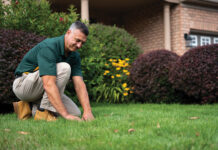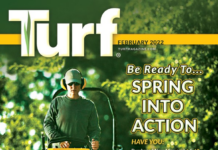Which would you prefer: fixing a problem or preventing one? Prevention tends to be more effective, costs less and provides turf managers and landscapers with an opportunity to control the situation rather than react to it.
Dealing with summer turf disease is inherently a weighty issue, usually complex and multifaceted. In fact, it’s much more sophisticated than other parts of the turf and ornamental care business that are on a predetermined maintenance schedule, such as lubricating the bearings on your spreaders and spray equipment or changing the oil in the pickup. Conversely, lessening the effects of summer turf disease through prevention involves a multitude of factors.

Be in control
Being in control of a summer disease problem before it starts is of utmost importance because they tend to be influenced by many factors, some of which you can’t do much about. Relative humidity, temperature, rainfall and other weather patterns are the most influential — and uncontrollable. In terms of weather, about the only control that a turf professional has is to keep track of it and compare the data to weather events in previous years.
On the plus side, thatch, cultivation, irrigation and fertilization are factors that can be manipulated to benefit your customers. Not only can they be controlled, they are essential cultural practices that can also be profitable.

History
Start with diseases that have been a problem in the past few years. American History may not have been your favorite topic in high school, but the pest history of your clients’ lawns and landscapes is something you should know about. In terms of usefulness, knowing when to look is just as important as knowing where to look. Unless your mind is like a steel trap, it can be tough to remember all the diseases that your customers’ lawns have been infected with over the past few years.
Because of the difficulty, records on disease occurrence should be kept for each property. The record should include the date it was first noticed, date of peak infection, control attempts — product, rate and timing — weather conditions and overall effectiveness of control. These records can be kept in a spiral notebook or on a computer, just find a system that works for you.

Identification
Spend time with a reference guide for turf diseases, such as “Controlling Turfgrass Pests” by Fermanian, Shurtleff, Randell and Wilkinson, and “Managing Turfgrass Pests” by Watschke, Shetlar and Dernoeden. Other guides are available as well, some from product manufacturers. The best guide orders them from spring to fall, contains lots of color pictures — preferably on various turf species — and a brief synopsis of the disease.
Signs and symptoms
It is useful to distinguish between signs and symptoms when training your staff, especially if they are new to the green industry. Generally, a sign is the visible part of the pest, while the symptom is the visible result of the pest acting on the plant.
A good example is a northern masked chafer grub in Kentucky bluegrass, where the symptoms are a generalized yellowing in a random but patchy pattern. The sign is the actual pest — the larval stages of the beetle, which feed on the roots of turf plants.

Patterns of typical diseases
Early to midsummer turf diseases can be divided a number of ways, but for this purpose, “patch” diseases and “irregular pattern” diseases will be discussed. Each are listed with gross overall and close-up symptoms. A brief description of each follows:
Patch diseases:
Dollar spot — Produces round patches in turf, 1 to 7 inches across, somewhat sunken. Leaves are covered with whitish leaf spots with brown or reddish brown borders. The spots usually cross the entire leaf blade, producing a banding appearance.
Pythium blight — Produces round patches in turf, 1 to 7 inches across, somewhat sunken, but differs in that tan leaf spots without reddish-brown borders are produced. Infected leaves are characteristically water-soaked and slimy to the touch.
Summer patch and necrotic ring spot — Produces round patches or rings 2 to 3 feet across, usually with green centers. Leaves are uniformly tan to brown. Blackened stem bases and roots are usually produced.
Brown patch — Produces patches 2 to 4 feet across, with erect leaf blades that have irregular blotches. The blotches usually do not cover the entire width of the leaf blade.
Leaf spot diseases:
Bipolaris leaf spot — Produces an irregular pattern, leaves with purplish to brown spots. Usually causes thinning of the turf and crown rots. Symptoms are usually present in early summer.
Rust — Produces an irregular pattern with a powdery mold on the leaf surfaces. Leaves with bright yellow, orange or brown pustules are present. Symptoms are usually present in late summer.
Ascochyta leaf spot — Irregular patterns of stressed turf, with leaves containing blotches or mottling; leaf tips often die back to the middle part of the leaf.

Timing
In terms of managing summer turf diseases, getting to know when early signs and symptoms are likely to occur is important. In August, looking for a disease that usually occurs in early summer won’t lead to success.
Scouting and monitoring
In order to get the jump on summer turf disease, frequent scouting and monitoring is mandatory. It’s usually the forgotten step in pest control. Actually, with veteran turf managers, it’s more of a “skip over” step, in that sure, they know that it’s something that should be done on a regular basis, but the temptation to ignore scouting is strong and easy to give in to — it always seems like there’s something more important to get done.
One of the reasons why integrated pest management (IPM) works so well is that if one of the many components fails or is cost-prohibitive, there are many more to utilize; that’s where scouting and monitoring fits in. When appropriate soil improvements, cultivar selection, cultivation, topdressing, fertilization, irrigation and mowing fail to completely control a disease problem, embarking on a thorough scouting and monitoring regime can really bring results.

Latest products
Using the “greatest and latest” is more involved than one might think. First, how do you find out about the latest products? Generally, university websites and field days, trade shows and local distributors are good options to learn about newly released fungicides.
Secondly, why use the latest products? It’s always good to add to your arsenal and create the opportunity to control a disease better than you could have the year before. Ignoring the new introductions is akin to sticking your head in the sand.
Third, why not stay with the same ones you used last year? This is a valid question; after all, you already know how to use them, and they tend to be less expensive. The bottom line is using effective fungicides that fit within the overall budget established for each customer.
Finally, it’s crucial to become thoroughly familiar with a new product — its timing, effective rates, suggested protective clothing to be worn, target diseases, mixing instructions, restrictions and limitations. As with any pesticide product, the label and MSDS information are the best sources for this information.











![[VIDEO] Dickies®: Discover Workwear That’s Anything But Uniform](https://turfmagazine.com/wp-content/uploads/2023/06/1647663814-4b1a2a7742790a9b1e97a3b963477850192e1d6a9dfba9b07214a77bae25d6e3-d-218x150.jpg)




























![[VIDEO] Dickies®: Discover Workwear That’s Anything But Uniform](https://turfmagazine.com/wp-content/uploads/2023/06/1647663814-4b1a2a7742790a9b1e97a3b963477850192e1d6a9dfba9b07214a77bae25d6e3-d-324x160.jpg)